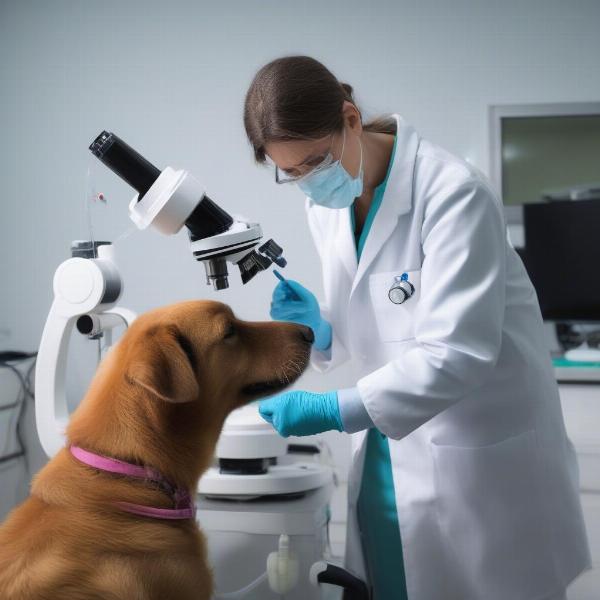Atropine eye ointment is a commonly used medication in veterinary ophthalmology. Understanding its uses, benefits, and potential risks is crucial for any dog owner. This guide provides a detailed overview of atropine eye ointment for dogs, covering everything from its mechanism of action to proper administration and potential side effects.
What is Atropine Eye Ointment and How Does it Work?
Atropine belongs to a class of drugs called anticholinergics. It works by blocking the action of acetylcholine, a neurotransmitter that controls muscle contraction. In the eye, acetylcholine stimulates the iris sphincter muscle, causing the pupil to constrict. By blocking acetylcholine, atropine causes the pupil to dilate (mydriasis) and also paralyzes the ciliary muscle, which controls the eye’s ability to focus (cycloplegia). This effect is temporary and reversible.
Uses of Atropine Eye Ointment in Dogs
Veterinarians prescribe atropine eye ointment for a variety of reasons, including:
- Treating anterior uveitis: Uveitis is inflammation of the uvea, the middle layer of the eye. Atropine helps relieve pain and prevent complications by dilating the pupil and paralyzing the ciliary muscle, reducing spasms and adhesion formation.
- Facilitating eye examinations: Dilating the pupil allows for a better view of the internal structures of the eye, aiding in diagnosis.
- Pre- and post-operative use in eye surgery: Atropine can help prepare the eye for surgery and reduce post-operative inflammation.
- Treating corneal ulcers: While not a primary treatment, atropine can help alleviate pain associated with corneal ulcers.
How to Administer Atropine Eye Ointment
Administering eye medication to a dog can be challenging. Here’s a step-by-step guide:
- Wash your hands thoroughly: Hygiene is crucial to prevent introducing bacteria to the eye.
- Gently restrain your dog: Have someone help you hold your dog securely. A calm and reassuring approach is essential.
- Pull down the lower eyelid: This creates a small pocket or pouch.
- Apply a thin strip of ointment: Squeeze a small amount of ointment into the pocket, being careful not to touch the tip of the tube to the eye.
- Close the eye for a few seconds: This helps distribute the ointment evenly.
Potential Side Effects of Atropine Eye Ointment
While generally safe, atropine can cause some side effects, including:
- Dilated pupils: This is an expected effect but can make your dog’s eyes more sensitive to light.
- Blurred vision: The cycloplegic effect can temporarily blur vision.
- Increased heart rate: In some cases, atropine can cause a temporary increase in heart rate.
- Dry mouth: This is less common with topical application but can occur.
When to Contact Your Veterinarian
Contact your veterinarian immediately if you notice any of the following:
- Severe redness or swelling of the eye
- Excessive tearing or discharge
- Signs of pain or discomfort
- Any unusual behavior in your dog
 Veterinarian Examining a Dog's Eye
Veterinarian Examining a Dog's Eye
Conclusion
Atropine eye ointment is a valuable medication for treating various eye conditions in dogs. However, it’s essential to use it only under the guidance of a veterinarian. Understanding its uses, administration, and potential side effects can help ensure your dog’s eye health and well-being.
FAQ
- How long does atropine eye ointment take to work? The effects of atropine are typically seen within 30 minutes of application.
- Can I use human atropine eye ointment on my dog? No, always use medications specifically prescribed for veterinary use.
- How should I store atropine eye ointment? Store at room temperature, away from direct sunlight and moisture.
- What should I do if I miss a dose? Apply the missed dose as soon as you remember, and then continue with the regular schedule.
- Can atropine eye ointment be used long-term? Long-term use should be under the strict supervision of a veterinarian.
- Are there any alternatives to atropine eye ointment? Your veterinarian can discuss alternative treatment options depending on your dog’s specific condition.
- Can atropine eye ointment be used with other eye medications? Discuss all medications your dog is taking with your veterinarian to avoid potential interactions.
Further Reading on ILM Dog
- [Link to an article about eye care for dogs on ILM Dog – if available]
- [Link to an article about dog health on ILM Dog – if available]
- [Link to an article about administering medication to dogs on ILM Dog – if available]
ILM Dog is your one-stop resource for expert advice on dog care, breed selection, health, training, nutrition, grooming, and much more. We provide practical, reliable information for dog owners worldwide, regardless of their experience level. From puppy care to senior dog care and everything in between, ILM Dog offers insights and guidance to help you provide the best possible care for your canine companion. For any inquiries, contact us at [email protected] or call +44 20-3965-8624. Visit us at ILM Dog for more valuable resources and expert advice on dog care.